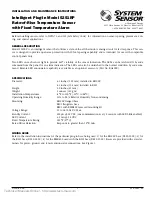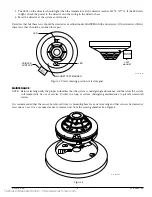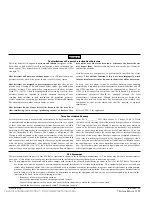
D200-89-00
4
I56-1332-02
© System Sensor 1999
Three-Year Limited Warranty
System Sensor warrants its enclosed heat detector to be free from defects
in materials and workmanship under normal use and service for a period
of three years from date of manufacture. System Sensor makes no other
express warranty for this heat detector. No agent, representative, dealer, or
employee of the Company has the authority to increase or alter the obliga-
tions or limitations of this Warranty. The Company’s obligation of this
Warranty shall be limited to the repair or replacement of any part of the
heat detector which is found to be defective in materials or workmanship
under normal use and service during the three year period commencing
with the date of manufacture. After phoning System Sensor’s toll free
number 800-SENSOR2 (736-7672) for a Return Authorization number,
send defective units postage prepaid to: System Sensor, Repair Depart-
ment, RA #__________, 3825 Ohio Avenue, St. Charles, IL 60174. Please
include a note describing the malfunction and suspected cause of failure.
The Company shall not be obligated to repair or replace units which are
found to be defective because of damage, unreasonable use, modifica-
tions, or alterations occurring after the date of manufacture. In no case
shall the Company be liable for any consequential or incidental damages
for breach of this or any other Warranty, expressed or implied whatsoever,
even if the loss or damage is caused by the Company’s negligence or fault.
Some states do not allow the exclusion or limitation of incidental or conse-
quential damages, so the above limitation or exclusion may not apply to
you. This Warranty gives you specific legal rights, and you may also have
other rights which vary from state to state.
WARNING
The Limitations of Property Protection Heat Detectors
may not be near where the fire occurs, or because the heat of the fire
may bypass them.
Heat detectors will not detect smoke, gas, flames, or
combustion particles.
Heat detectors are components in professionally installed fire alarm
systems.
They will not function if they have been improperly wired
into the fire alarm system or if power to them is cut off for any reason.
To keep your fire alarm system in excellent working order, ongoing
maintenance is required per the manufacturer’s recommendations and UL
and NFPA standards. At a minimum, the requirements of Chapter 7 of
NFPA 72, the National Fire Alarm Code, shall be followed. A preventative
maintenance agreement should be arranged through the local
manufacturer’s representative. Though heat detectors are designed for
long life, they may fail at any time. Any heat detector, fire system or any
component of that system which fails shall be repaired or replaced
immediately.
Refer to NFPA 72 for application.
This heat detector is designed to
activate and initiate
emergency action,
but will do so only when it is used in conjunction with an authorized fire
alarm system. This detector must be installed in accordance with NFPA
standard 72.
Heat detectors will not work without power.
AC or DC powered smoke
detectors will not work if the power supply is cut off for any reason.
Heat detectors are designed to protect property, not life.
They do not
provide early warning of fire and cannot detect smoke, gas, combustion
particles, or flame. They alarm when temperatures at the heat detector
reach 57
°
C (135
°
F). Given the rapid growth of certain types of fires, heat
detectors cannot be expected to provide adequate warning of fires
resulting from smoking in bed, inadequate fire protection practices,
violent explosions, escaping gas, improper storage of flammable liquids
like cleaning solvents, other safety hazards, or arson.
Heat detectors do not always detect fires because the fire may be a
slow-smoldering, low-heat type (producing smoke), or because they
FCC Statement
This device complies with part 15 of the FCC Rules. Operation is subject to the following two conditions: (1) This device may not cause harmful interfer-
ence, and (2) this device must accept any interference received, including interference that may cause undesired operation.
Note: This equipment has been tested and found to comply with the limits for a Class B digital device, pursuant to Part 15 of the FCC Rules. These limits
are designed to provide reasonable protection against harmful interference in a residential installation. This equipment generates, uses and can
radiate radio frequency energy and, if not installed and used in accordance with the instructions, may cause harmful interference to radio commu-
nications. However, there is no guarantee that interference will not occur in a particular installation. If this equipment does cause harmful interfer-
ence to radio or television reception, which can be determined by turning the equipment off and on, the user is encouraged to try to correct the
interference by one or more of the following measures:
– Reorient or relocate the receiving antenna.
– Increase the separation between the equipment and receiver.
– Connect the equipment into an outlet on a circuit different from that to which the receiver is connected.
– Consult the dealer or an experienced radio/TV technician for help.
Technical Manuals Online! - http://www.tech-man.com






















